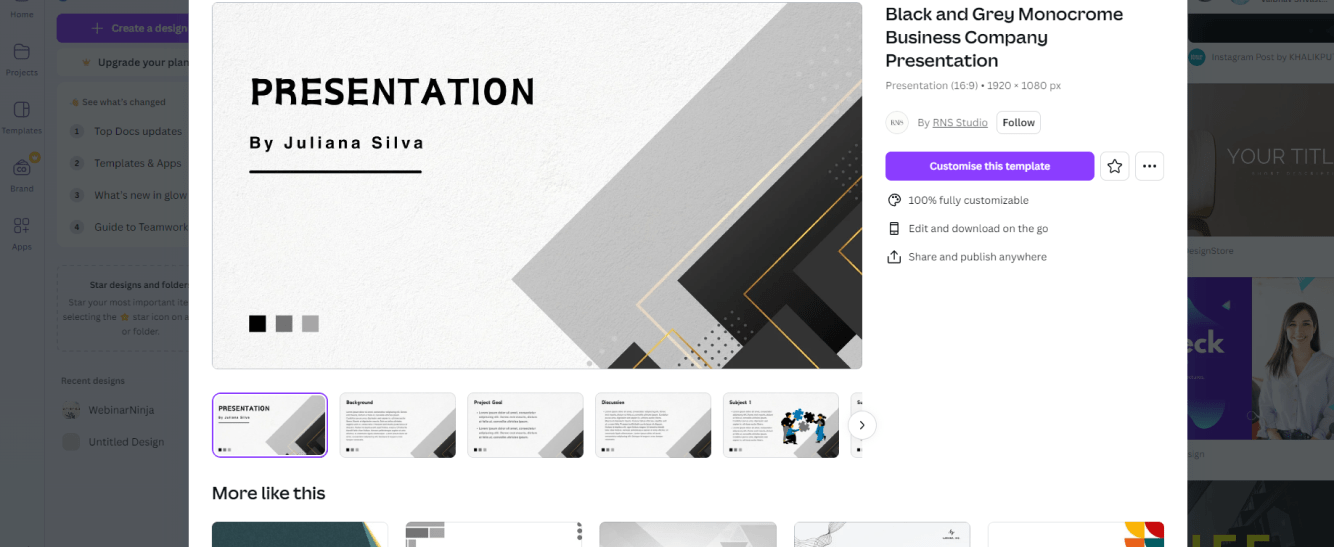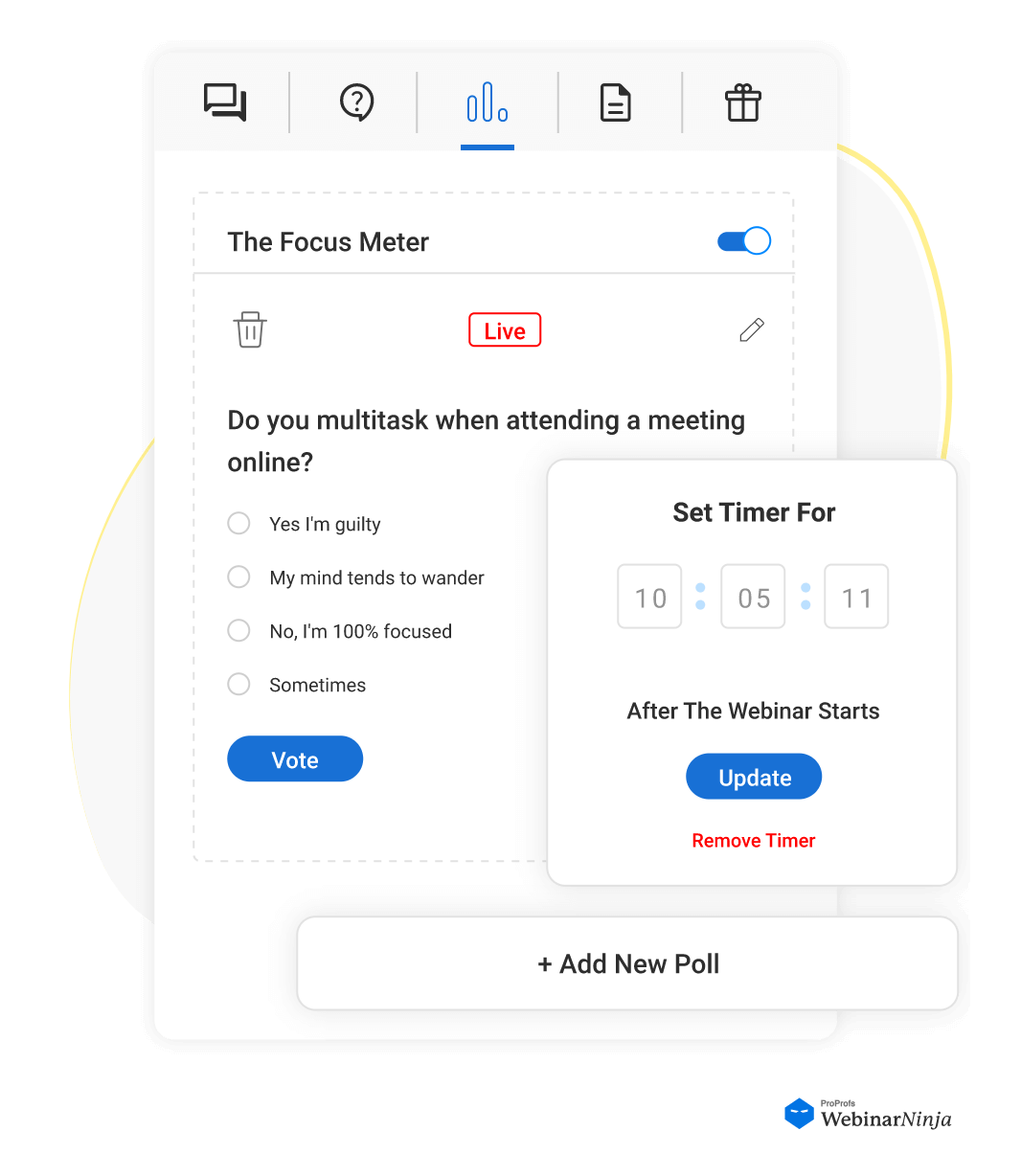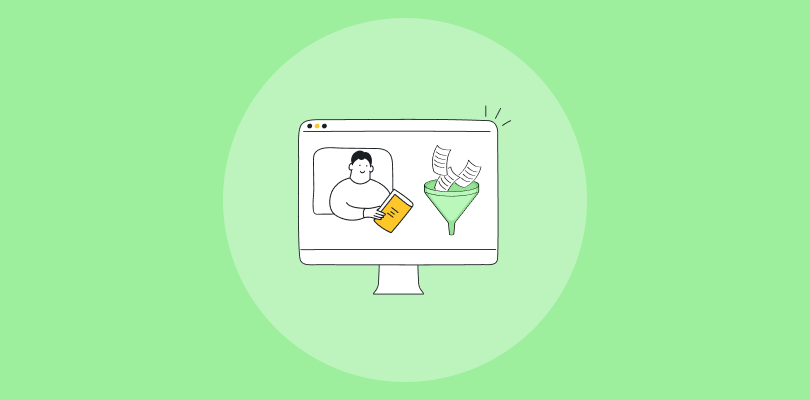Good webinar formula: ✅ Check
Created a good webinar: ✅ Check
Followed up with the attendees: ✅ Check
Got enough attention: ❌ Not as expected
You’ve done everything by the book—yet your webinar isn’t bringing in clients the way it should.
What’s the problem? Most webinars focus too much on delivering knowledge and too little on guiding attendees toward action.
That’s where the TOKYO Method changes the game. With a structured approach that emphasizes engagement, trust, and conversions, you’ll finally turn your webinars into a client-winning strategy.
Let’s dive deeper to get a better idea of this topic:
What Is the TOKYO Method?
TOKYO is an acronym that stands for:
- T – Topic (The promise of your webinar)
- O – Outline (Your roadmap to delivering value)
- K – Keynote (Your slides and storytelling framework)
- Y – Your Engagement (How to keep attendees involved)
- O – Offer (The structure that drives conversions)
Each step builds trust with your audience and brings them closer to becoming a client.
Let’s understand each of these components in a bit more detail.
T – Topic: The Foundation of a High-Trust Webinar
Your webinar topic is the promise you make to attendees. When someone registers, they expect to receive exactly what was advertised. If you don’t deliver, trust is broken, and future engagement suffers.
Think about it: if you sign up for a webinar called “How to Groom Your Persian Cat in 5 Minutes,” you expect to learn a quick and effective grooming method.
But if the session turns into a long-winded sales pitch about premium pet grooming tools without providing the actual steps, attendees feel misled. They leave frustrated, and the likelihood of them attending another one of your webinars plummets.
How to Choose a Webinar Topic That Converts
The best webinar topics address your audience’s biggest challenges. They provide immediate value while also naturally positioning your expertise. Here’s how to find the right one:
Identify the #1 Problem Your Audience Faces
Start by pinpointing the biggest pain point in your industry. You can consider:
- What do your customers struggle with the most?
- What are the most common questions you get from leads and clients?
- How does your product or service solve a major frustration?
A webinar that tackles a pressing problem makes it irresistible to potential attendees.
Make Your Topic-Specific
Broad, generic topics fail to excite people. The more precise your webinar title, the more compelling it becomes. Compare:
- Instead of “How to Run a Webinar,” try “How to Create a High-Converting Webinar in 30 Minutes”.
- Instead of “How to Lose Weight,” try “How to Lose 10 Pounds Without Cutting Carbs”.
Specificity not only grabs attention but also sets clear expectations for what attendees will gain.
Ensure You Can Deliver on the Promise
A high-trust webinar sticks to its promise. If your title makes a big claim, your content must follow through. Before finalizing your topic, ask yourself:
- Can I confidently teach this in a webinar format?
- Will attendees walk away with actionable knowledge?
- If results are promised, are they realistic?
If you can’t guarantee the outcome in your title, reframe it. A compelling webinar topic makes attendees think, “I NEED to be on this webinar!”—and when you deliver, they’ll keep coming back for more.
O – Outline: Your Lesson Plan for Delivering Value
Once you’ve nailed down a compelling topic, structuring your webinar effectively is key to keeping your audience engaged and making them feel like they’re walking away with real value.

A well-structured webinar isn’t just informative—it’s persuasive. It leads attendees through a logical journey that builds trust, demonstrates expertise, and naturally positions your product or service as the best solution to their problem.
The Three “Mic Drop Moments”
The most impactful webinars aren’t overloaded with information—they center around three powerful insights, or what we call Mic Drop Moments. These are the three biggest takeaways that make your audience think, “Wow, I need this!” They’re also what solidify your credibility and prove why your solution is worth considering.
For example, if your webinar topic is “How to Launch a Profitable Online Course in 30 Days”, your Mic Drop Moments could be:
- A Proven Course Framework (so you don’t waste time figuring out what works)
- A No-Fail Marketing Plan (so you can attract students without expensive ads)
- Automated Enrollment & Payments (so you can make money while you sleep)
Each mic drop moment should be backed by three supporting reasons that explain why it’s valuable.
Let’s take A No-Fail Marketing Plan as an example:
- Step-by-Step Templates – So you don’t need to start from scratch.
- Email & Social Media Scripts – So you can promote your course with ease.
- Built-in Audience Growth Strategies – So you keep attracting students, even after launch.
This structure keeps your webinar engaging, helps attendees connect the dots, and builds trust. Instead of just telling your audience what works, you’re showing them exactly how you can help. And that’s what turns listeners into loyal customers.
K – Keynote: How to Structure Your Slides Like a Pro
Your keynote (a.k.a. slide deck) isn’t just a visual aid—it’s a storytelling tool that reinforces your message and keeps your audience engaged. A well-structured slide deck can make the difference between an engaging webinar and one that loses attention fast.

The Perfect Webinar Slide Structure
Each slide in your presentation should serve a clear purpose, guiding attendees through your webinar in a way that feels natural, informative, and persuasive. Here’s a winning structure:
- Title Slide – Remind attendees why they are here and reinforce the promise of the webinar.
- Transparent Overview – Outline what you’ll cover, including any special offer. Setting expectations builds trust.
- Host Slide – Share your personal story. Why are you the right person to teach this? A touch of authenticity helps connect with your audience.
- Mic Drop Moments – The core lessons of your webinar. These should be structured with supporting points that reinforce their value.
- Smooth Transition – Lead from the educational portion into your offer in a way that feels natural, not forced.
- Q&A Session – Open the floor to engage with attendees. Answering live questions builds credibility and trust.
- Final Offer Slide – Reinforce the value of your offer and why attendees should act now. Urgency helps drive conversions.
The Power of Transparency
One of the biggest mistakes presenters make is hiding their offer until the last second. Instead, be upfront about it. Let your audience know early on that you’ll be making an offer, but make it clear that the webinar itself delivers value, even if they don’t buy. This approach keeps people engaged rather than feeling like they’ve been lured into a sales pitch.
When structured correctly, your slides won’t just support your message—they’ll enhance the experience, making your webinar more engaging, informative, and persuasive.
Y – Your Engagement: How to Keep Attendees Hooked
If you don’t actively engage your audience, they’ll zone out—or worse, leave your webinar entirely. Engagement isn’t just about keeping attendees entertained; it directly impacts trust, retention, and ultimately, sales. The more involved your audience feels, the more likely they are to stay until the end and take action.
The “Minute of Power” – Start with Energy
The first minute of your webinar sets the tone for the entire session. It’s your chance to grab attention, make attendees feel welcome, and train them to engage early. Here’s how to kick things off with high energy and interaction:
- Warm Welcome – Greet attendees with enthusiasm. A friendly, high-energy opening makes people feel like they’re in the right place.
- Ask a Simple Question – Something easy like, “Where are you tuning in from?” encourages immediate participation.
- Personalized Engagement – Mention specific names when responding: “Hey John, I love New York! Which part are you from?” This small touch makes the experience feel more personal.
- Start a Poll – Even introverts are more likely to participate when given an easy, clickable way to engage. Polls also give you valuable audience insights.
- Keep Energy Levels High – People naturally mirror the energy of the host. When you’re upbeat and excited, they associate that positivity with your brand.
Engagement Is a Habit—Train Your Audience
Interaction isn’t automatic; it needs to be encouraged from the start. If webinar attendees engage early on, they’re much more likely to continue participating throughout the webinar.
To maintain engagement beyond the first minute:
- Ask Questions Throughout – Break up the content with moments that invite responses.
- Encourage Chat Participation – Acknowledge comments, answer questions, and create a dialogue.
- Use Interactive Features – Polls, emoji reactions, and live Q&A keep things dynamic.
- Keep Up the Momentum – Avoid long monologues. Mix things up with stories, visuals, and audience interactions.

The key takeaway? The more engaged your audience feels, the more invested they’ll be in your message—and in your offer.
O – Offer: The Right Way to Sell Without Feeling “Salesy”
You’ve provided value. You’ve built trust. Now comes the moment many presenters struggle with—making the offer. But here’s the truth: if your product or service genuinely helps people, selling isn’t sleazy—it’s helpful.
The key is presenting your offer in a way that feels natural, not pushy. When done right, your audience won’t feel like they’re being “sold to”—they’ll feel excited to buy.
The Offer Flow That Converts

A structured, trust-based approach to selling makes all the difference. Here’s how to seamlessly transition from delivering value to making an irresistible offer:
1. What They Get – Spell out exactly what’s included
People need clarity before they buy. Outline everything they’ll receive in your offer, including:
- The core product or service (explain it in simple, benefit-driven language).
- Any bonuses that add extra value (e.g., free coaching, additional resources, templates).
- Ongoing support (help desk, community access, check-ins).
By making the offer feel tangible and packed with value, you build excitement and lower hesitation.
2. Success Story #1 – Show proof that it works
People trust results, not promises. Share a real success story from someone who has used your solution and seen meaningful results. Ideally, make it relatable—something that makes attendees think, “That could be me!”
3. Why They Need to Buy Now – Create urgency
A great offer loses momentum if people think they can come back “later.” Help them take action now by creating genuine urgency:
- Limited spots or availability – “Only 20 spots left.”
- Limited-time pricing – “This special price expires in 24 hours.”
- Exclusive bonuses – “Only for webinar attendees.”
Urgency works when it’s real—be honest about your limitations, and people will respond.
4. Another Success Story – Reinforce credibility
Not everyone relates to the first success story, so show another one. Highlight a different type of customer or a different way they benefited. This reassures attendees that your solution works for various situations.
5. Investment – State the price with confidence
When it’s time to reveal the price, own it. Avoid apologetic language like, “I know this might sound expensive…” Instead, frame it as an investment in their success. If relevant, break it down in a way that makes it feel manageable (e.g., monthly payment options).
6. Final Success Story – Remind them of the potential results
One last success story brings everything full circle. It helps people visualize what’s possible if they say yes to your offer.
7. How to Buy – Make It EASY
If someone is interested, don’t make them jump through hoops. Clearly explain:
- Where to go to purchase (provide a direct link).
- How to check out (step-by-step if necessary).
- What happens after they buy (confirmation email, onboarding, next steps)?
The Three-Option Close
At the very end, guide attendees toward making the best decision. Give them three choices:
- Do nothing – Keep struggling with the same problems.
- Try another option – Risk wasting time and effort on something unproven.
- Choose your solution – Get fast, proven results with a trusted system.
This method makes it clear and logical why choosing your offer is the best path forward—without pressure, just facts.
What Are the Benefits of the TOKYO Method?
The TOKYO Method is designed to help you create highly engaging, value-driven, and conversion-focused webinars that feel natural rather than forced.
Here are the key benefits of using this method:
1. Builds Immediate Trust with Attendees
Webinars are most effective when attendees trust the host and believe they will receive the value they were promised.
The TOKYO Method ensures that:
- Your webinar title and content align so that attendees don’t feel misled.
- The session starts with a warm, interactive opening that sets a positive tone.
- Attendees receive real, actionable insights rather than vague or surface-level advice.
When people feel they’re learning something valuable from you, they’re more likely to stay until the end and trust any recommendations you make.
2. Keeps Webinars Structured and Engaging
A poorly structured webinar feels scattered, overwhelming, or boring, which leads to attendees losing interest or dropping off before the session ends.
A strong structure ensures:
- The key points are clear and easy to remember.
- There’s a logical flow that builds momentum instead of overwhelming attendees with too much information at once.
- People stay engaged from start to finish instead of passively watching.
This makes the webinar feel valuable, well-organized, and impactful, increasing the chances that attendees take action at the end.
3. Enhances Audience Engagement and Interaction
Most webinars fail because they lack interaction. Attendees are more likely to tune out if they’re just being talked at for an hour.
The TOKYO Method focuses on:
- Encouraging participation early (e.g., asking questions, running polls, or using chat engagement).
- Using storytelling and real-world examples to keep the content relatable and easy to follow.
- Breaking up long sections with interactive elements to hold attention.
Engagement isn’t just about making the webinar enjoyable—it also builds trust and connection, making attendees more receptive to the final offer.
4. Makes Information Easy to Absorb and Retain
If people don’t understand or remember what they learned, they won’t take action.
The TOKYO Method uses:
- Clear, structured takeaways (instead of information overload).
- Visually appealing slides that support—not distract from—the message.
- Simple, actionable insights that attendees can implement immediately.
This makes it easier for attendees to grasp complex ideas, see the value in your offer, and feel confident moving forward.
5. Transitions from Education to Selling Without Feeling Pushy
Many webinar hosts struggle with the sales portion of their presentation. Either they don’t sell at all (leaving money on the table), or they come off as too aggressive.
The TOKYO Method:
- Gradually builds up to the offer instead of surprising attendees at the end.
- Provides success stories and proof to reinforce the value of the product or service naturally.
- Creates a sense of urgency without using high-pressure tactics.
By the time the offer is presented, attendees feel like it’s a logical and valuable next step, making them much more likely to say yes.
6. Increases Conversion Rates and Sales
A webinar’s success is ultimately measured by how many attendees take action at the end—whether it’s purchasing a product, signing up for a service, or booking a consultation.
Because the TOKYO Method:
- Builds trust from the beginning,
- Keeps engagement high throughout, and
- Presents the offer in a way that feels natural,
…it significantly increases the number of people who convert compared to traditional webinar formats.
7. Reduces Drop-Off Rates and Keeps Attendees Until the End
One of the biggest challenges with webinars is keeping people from leaving early. If attendees drop off before you present your offer, you’ve lost the opportunity to convert them. The TOKYO Method helps prevent this by:
- Capturing attention early with a strong introduction.
- Structuring content in engaging sections that maintain curiosity.
- Encouraging participation to make attendees feel involved.
This leads to higher retention rates, more conversions, and a more engaged audience overall.
8. Makes Selling Feel More Authentic and Natural
No one likes feeling like they’re being pressured into buying something. The TOKYO Method ensures that selling doesn’t feel like selling by:
- Leading with value so attendees see you as a helpful guide, not just a salesperson.
- Using real-world success stories to demonstrate the product’s effectiveness.
- Presenting the offer as a solution rather than a sales pitch.
When people genuinely believe they need what you’re offering, sales happen organically—without feeling awkward or forced.
9. Saves Time and Effort by Providing a Repeatable Framework
Instead of reinventing the wheel every time you host a webinar, the TOKYO Method gives you a proven, repeatable structure that you can refine and improve over time. This means:
- Less stress in planning because you know exactly how to structure your presentation.
- Consistently strong results as you refine and optimize the method.
- You have more confidence in hosting webinars because you have a clear game plan that works.
By following a structured approach, you spend less time figuring out what works and focusing more on delivering a great experience.
Use TOKYO, Build Trust, Get More Clients
The TOKYO Method is more than just a webinar framework. It’s a trust-building system that keeps your audience engaged, delivers real value, and seamlessly guides them toward a purchase.
By structuring your webinars with clear takeaways, interactive elements, and a well-positioned offer, you create an experience that educates, captivates, and converts. Implementing this method ensures that your webinars don’t just inform but also drive action and sales.
To further enhance your webinars, you can use a powerful webinar platform like WebinarNinja. Its built-in engagement tools, automation, and marketing features make it even easier to apply the TOKYO Method and maximize your results.
Want to host a webinar for free?
Use WebinarNinja to teach, improve marketing, and grow your sales.






